skin cancer
Skin Cancers
Skin cancer is the most prevalent of all types of cancers. It is estimated that more than one million Americans develop skin cancer every year.
Sun avoidance is the best defense against skin cancer! Over-exposure to sunlight (including tanning) is the main cause of skin cancer especially when it results in sunburn and blistering. Fair skinned people who sunburn easily are at particularly high risk for skin cancer.
Prevention means guarding the skin against the known causes of skin cancer. Since the sun’s ultraviolet rays are the main culprit, the most effective preventive method is sun avoidance.
It is recommended to begin early use of sun protection in childhood because it is estimated that 80 percent of lifetime sun exposure occurs before age 18. Children under six months of age should not have prolonged sun exposure.
Early detection is the surest way to a cure. Develop a regular routine to inspect your body for any skin changes. If any growth, mole, sore, or skin discoloration appears suddenly or begins to change, see your dermatologist.
Other skin-protective measures include:
Shade
Seek shade between 10:00a.m. and 4:00p.m. when the UV rays are the most intense.
Wardrobe
Sunscreen
Apply a broad-spectrum sunscreen with a SPF of at least 30 and reapply every 90 minutes when outside.
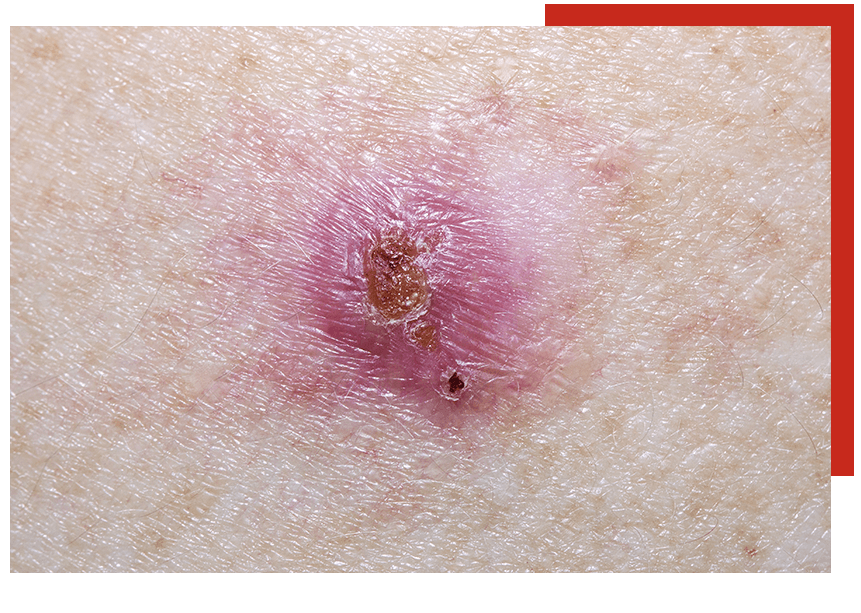
Precancerous Skin Conditions
Actinic keratoses are small, scaly spots most commonly found on the face, ears, neck, lower arms, and back of the hands in fair-skinned individuals who have had significant sun exposure. Actinic keratoses can be removed by cryotherapy (freezing) or by applying a cream form of chemotherapy.
Cancerous Skin Condititons
There are three forms of skin cancer:
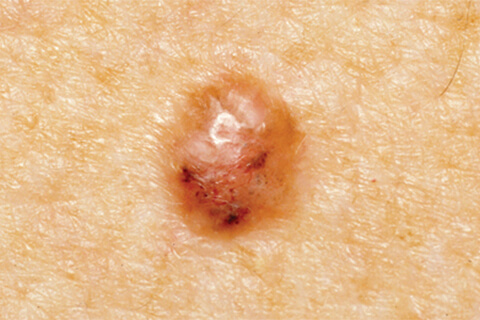
Basal Cell Carcinoma (BCC)
Basal cell carcinoma is the most common type of skin cancer and appears frequently on the head, neck, and hands as a small, fleshy bump, nodule, or red patch. Other parts of the body may be affected as well. Basal cell carcinomas are frequently found in fair-skinned people and rarely occur in dark skin. They do not spread quickly. It can take many months or years for one to grow to a diameter of one-half inch. Untreated, the cancer often will begin to bleed, crust over, heal, and repeat the cycle.
Although this type of cancer rarely metastasizes (spreads to other parts of the body), it can extend below the skin, causing considerable local damage.
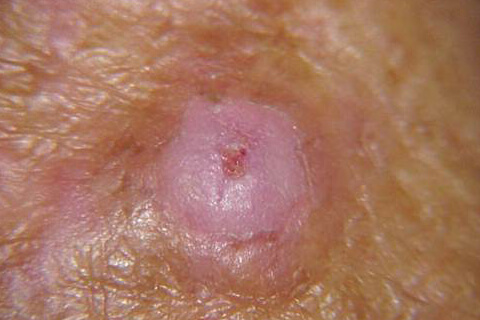
Squamous Cell Carcinoma (SCC)
Squamous cell carcinoma is the second most common skin cancer; it is primarily found in fair-skinned people and rarely in dark-skinned individuals. Typically located on the rim of the ear, the face, lips, and mouth, this cancer may appear as a bump, or as a red, scaly patch. Unlike basal cell carcinoma, this form of cancer can metastasize (spread to other parts of the body); therefore, it is important to get early treatment. When found early and treated properly, the cure rate for both basal cell and squamous cell carcinomas is over 95 percent.
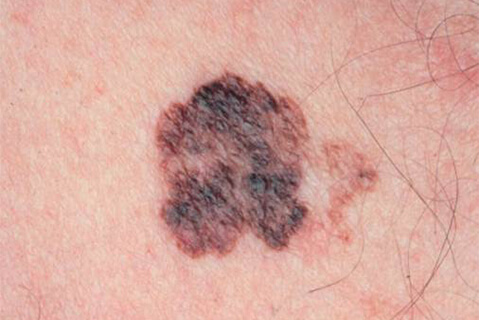
Malignant Melanoma
Malignant melanoma is the most deadly of all skin cancers. Every year, an estimated 7,700 Americans will die from melanoma; it is projected that greater than 46,000 Americans will develop melanoma annually. The death rate is declining because patients are seeking help sooner and it is usually curable when detected in its early stages.
Melanoma may appear suddenly or begin in or near a mole, or another dark spot in the skin. It is important to know the location and appearance of the moles on the body to detect changes early. Any changing mole must be examined by a dermatologist. Early melanoma can be removed while still in the curable stage.
Excessive sun exposure, especially sunburn, is the most important preventable cause of melanoma. Light-skinned individuals are at particular risk.
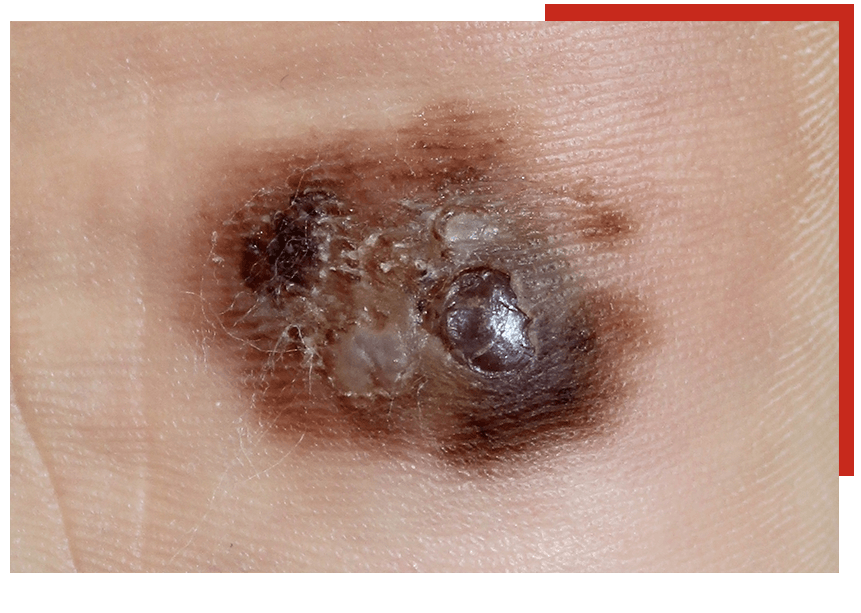
Treatment of Skin Cancer
If a skin biopsy reveals skin cancer, your dermatologist will likely recommend additional treatment. There are several procedures that can treat skin cancer. When deciding a treatment plan, the dermatologist will make their recommendation depending upon the type of skin cancer, its location on the body, and the needs of the patient.
Mohs Micrographic Surgery
Mohs micrographic surgery is a special surgical treatment used specifically for skin cancer. It is used to treat and remove basal cell carcinomas and squamous cell carcinomas of the skin. Occasionally it is used to treat a type of melanoma called Lentigo Maligna. Mohs surgery is often recommended as a treatment for skin cancers located on the face, scalp, neck, hands, feet, and genitals.
During Mohs surgery, the surgeon precisely removes the skin cancer and examines the involved tissue under the microscope. This allows the surgeon to make sure the cancer is completely removed. If they see cancer cells present under the microscope, they will then remove additional tissue. Mohs surgery allows the removal of all cancerous cells for the highest cure rate, while sparing healthy tissue.
Mohs Surgery At Sutton Dermatology
At Sutton Dermatology we have 11 surgical suites at three different locations for dermatologic procedures, skin cancer excisions, and Mohs micrographic surgery. We have two onsite histology labs that allow us to process the tissue for Mohs surgery efficiently. This all allows for surgical removal, verified clear margins, and closure on the same day. This leads to maximum cost savings for our patients.
The Importance of Fellowship Training
When choosing a Mohs micrographic surgeon, it is important that your surgeon has undergone an accredited Mohs Micrographic Surgery and Dermatologic Oncology fellowship. Both of our Mohs surgeons, Dr. Leigh Sutton and Dr. Elizabeth Sutton, completed accredited Mohs Micrographic Surgery fellowships after their dermatology residencies. They are both double Board Certified in Dermatology and Micrographic Dermatologic Surgery.
Schedule your Appointment
Ready to schedule an appointment with our team of aesthetic experts? Call our office at 402.484.9009 or fill out our Contact Us form and we would be happy to get you scheduled.



